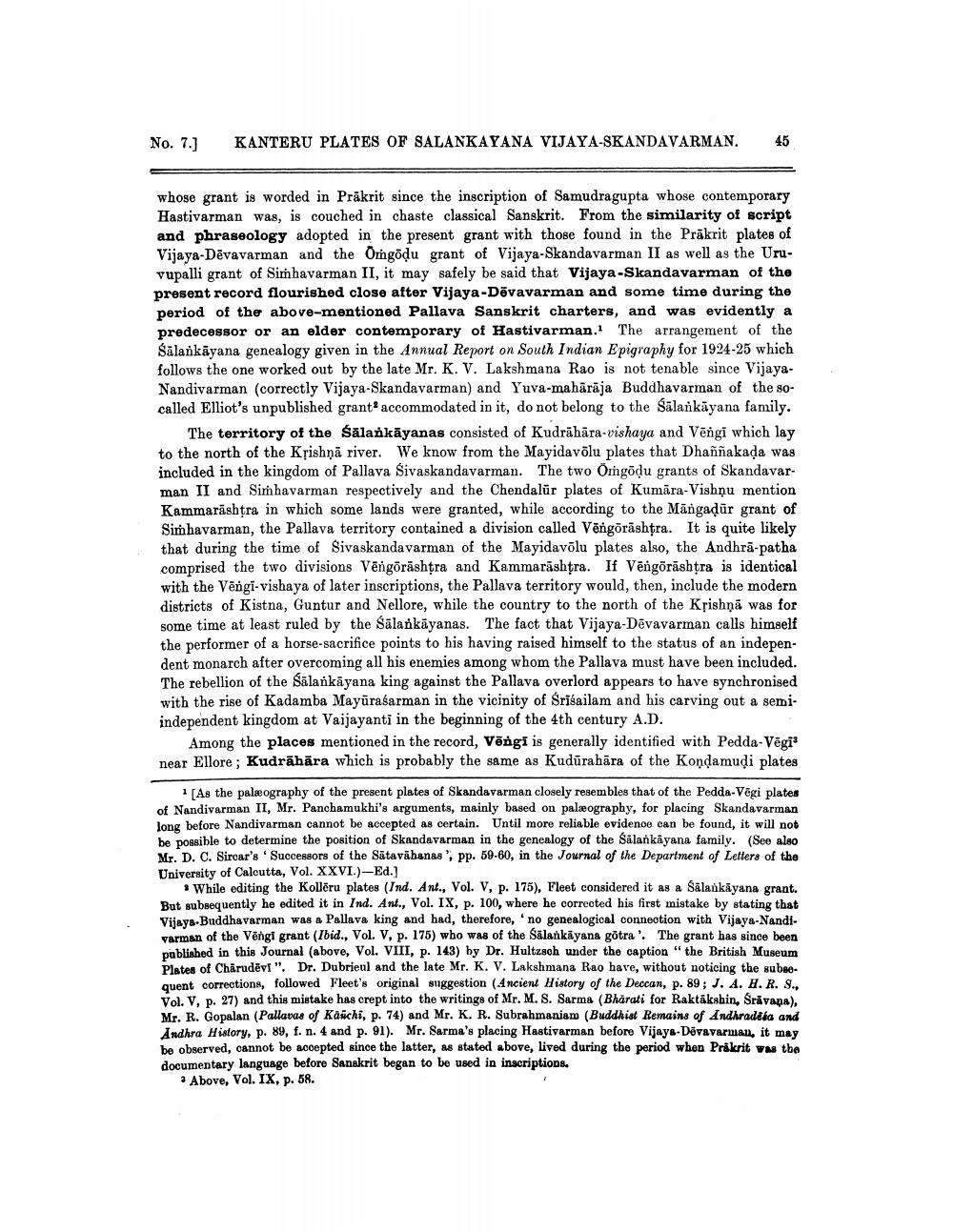________________
No. 7.)
KANTERU PLATES OF SALANKAYANA VIJAYA-SKANDAVARMAN.
45
whose grant is worded in Prākrit since the inscription of Samudragupta whose contemporary Hastivarman was, is couched in chaste classical Sanskrit. From the similarity of script and phraseology adopted in the present grant with those found in the Präkrit plates of Vijaya-Dēvavarman and the Omgõdu grant of Vijaya-Skandavarman II as well as the Uruvupalli grant of Simhavarman II, it may safely be said that Vijaya-Skandavarman of the present record flourished close after Vijaya-Dēvavarman and some time during the period of the above-mentioned Pallava Sanskrit charters, and was evidently a predecessor or an elder contemporary of Hastivarman. The arrangement of the Sālankāyana genealogy given in the Annual Report on South Indian Epigraphy for 1924-25 which follows the one worked out by the late Mr. K. V. Lakshmana Rao is not tenable since VijayaNandivarman (correctly Vijaya-Skandavarman) and Yuva-mahārāja Buddhavarman of the socalled Elliot's unpublished grant accommodated in it, do not belong to the Salankäyana family.
The territory of the Sālaňkāyanas consisted of Kudrāhāra-vishaya and Vēngi which lay to the north of the Kțishņā river. We know from the Mayidavõlu plates that Dhaññakada was included in the kingdom of Pallava Sivaskandavarman. The two Omgõdu grants of Skandavarman II and Simhavarman respectively and the Chendalūr plates of Kumāra-Vishņu mention Kammarāshtra in which some lands were granted, while according to the Māngadur grant of Simhavarman, the Pallava territory contained a division called Vērgārāshtra. It is quite likely that during the time of Sivaskandavarman of the Mayidavõlu plates also, the Andhrā-patha comprised the two divisions Vēngārāshtra and Kammarāshtra. If Vēngārāshțra is identical with the Vēngi-vishaya of later inscriptions, the Pallava territory would, then, include the modern districts of Kistna, Guntur and Nellore, while the country to the north of the Krishņā was for some time at least ruled by the Sālaňkāyanas. The fact that Vijaya-Dévavarman calls himself the performer of a horse-sacrifice points to his having raised himself to the status of an independent monarch after overcoming all his enemies among whom the Pallava must have been included. The rebellion of the Sālankāyana king against the Pallava overlord appears to have synchronised with the rise of Kadamba Mayūraśarman in the vicinity of Srisailam and his carving out a semiindependent kingdom at Vaijayanti in the beginning of the 4th century A.D.
Among the places mentioned in the record, Võngi is generally identified with Pedda-Vēgi: near Ellore ; Kudrāhāra which is probably the same as Kudūrahāra of the Kondamudi plates
1[As the palæography of the present plates of Skandavarman closely resembles that of the Pedda-Vögi plates of Nandivarman II, Mr. Panchamukhi's arguments, mainly based on palæography, for placing Skandavarman long before Nandivarman cannot be accepted as certain. Until more reliable evidence can be found, it will not be possible to determine the position of Skandavarman in the genealogy of the Sālańkāyana family. (See also Mr. D. C. Sircar's 'Successors of the Sātavābanas, pp. 59-60, in the Journal of the Department of Letters of the University of Calcutta, Vol. XXVI.)-Ed.)
While editing the Kollēru plates (Ind. Ant., Vol. V, p. 175), Fleet considered it as a Sālankāyana grant. But subsequently he edited it in Ind. Ant., Vol. IX, p. 100, where he corrected his first mistake by stating that Vijaya-Buddhavarman was a Pallava king and had, therefore, 'no genealogical connection with Vijaya-Nandivarman of the Vēngi grant (Ibid., Vol. V, p. 175) who was of the Salankāyana gotra'. The grant has since been published in this Journal (above, Vol. VIII, p. 143) by Dr. Hultzsch under the caption " the British Museum Plates of Chărudēvi". Dr. Dubrieul and the late Mr. K. V. Lakshmana Rao have, without noticing the subsequent corrections, followed Fleet's original suggestion (Ancient History of the Deccan, p. 89; J. A. H. R. S.. Vol. V, p. 27) and this mistake has crept into the writings of Mr. M. S. Sarma (Bharati for Raktākabin, Sravana), Mr. R. Gopalan (Pallavas of Kanchi, p. 74) and Mr. K. R. Subrahmaniam (Buddhist Remains of Andhradéka and Andhra History, p. 89, f. n. 4 and p. 91). Mr. Sarma's placing Hastivarman before Vijays-Dāvavarman, it may be observed, cannot be accepted since the latter, as stated above, lived during the period when Prakrit was the documentary language before Sanskrit began to be used in inscriptions
. Above, Vol. IX, p. 58.




